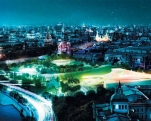Architecture as the Management of Public Life

The profession of an architect becomes more and more versatile. People, who work in this sphere, have to decide various questions concerning human environment. What role does architecture play in the life of modern society? How to implement the best practices of global experience in Moscow while preserving its individuality? These and other questions we have addressed to the Chief Architect of Moscow Sergey Kuznetsov, who made time in his tight schedule to answer them.
Sergey Olegovich, what does it mean to be the chief architect of Moscow? How does your current work differ from what you did before?
I have worked as an architect all my life, but one should understand that we are the witnessing of considerable transformations in the industry of public environment creation. Moreover, there emerge different kinds of occupations, professions, of which, of course, we have known before, but now they take on a new meaning: urban specialist, landscape designer. Today we speak about the creation of public spaces, of which significance we haven’t spoken ever before. In other words the profession itself is transforming and dividing into various elements, and all of them require a different quality of expertise – in law, economics and so on. The profession of an architect is more versatile today if compared to its perception in XVIII-XIX centuries, although we might not know everything, and there were other objectives. But today in response to technological development, strict deadlines for project realization and increasing of economic accountability, an architect – this is a person who shall be a many-sided qualified specialist.
To be the chief architect is even more difficult, since there are more challenges and they are more global. To deal with urban development in general, especially in a city like Moscow, which is still bigger than any other, is a separate matter. Undoubtedly, on the one hand, it adds difficulty, but on the other – interest. I definitely understood that it’s an entirely different challenge compared to the design of individual buildings or even big complexes in Moscow. There are a lot of nuances and briefly speaking it’s a very interesting job. I am very glad to do it, I’m full of different ideas as to what and how to develop in the city.
How do the city authorities take your ideas? Obviously, without the Moscow Mayor’s support it would be hard to accomplish such large-scale transformations of the urban environment.
Certainly, integrated urban reorganization and alteration of perception are initiated by the city authorities. It would be wrong to suppose that I came and started bossing around: let’s do everything in different way. It was the initiative of the Moscow Mayor, and the fact that I was invited to this position is directly connected with it. Let’s not confuse the cause-and-effect relationship, that is, first there was the city authorities’ decision and afterwards - I was invited as a person who is ready and able to do it. We all work here, in our focal areas, to coordinate tactical issues, how and what to do, generate ideas, and suggest doing one or another way. When ideas are appreciated and supported – it is a great incentive.
Full content of this issue you can read here
The full version of the article can be read in our printed issue, also you can subscribe to the web-version of the magazine
 Interviewer Kira Ivanova
Interviewer Kira Ivanova


